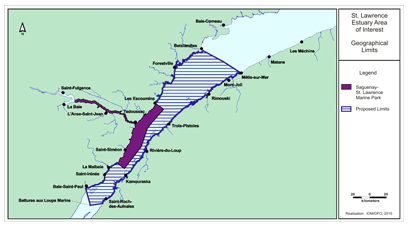St. Lawrence Estuary Area of Interest (AOI)
Note:
The maps, diagrams and coordinates on this website are provided for general information and are not to be used for fishing, navigation and other purposes. Please contact your regional DFO office for official coordinates.
Note:
This area is now considered for protection under Parks Canada’s expansion of the Saguenay-Saint-Lawrence Marine Park.
Location
Location
The St. Lawrence Estuary Area of Interest covers approximately 6000 km² and is complementary to and lies adjacent to the Saguenay-St. Lawrence Marine Park, a marine protected area created in 1998 by Québec and Canada mirror legislation, and co-managed by Parks Canada and the Société des établissements de plein air du Québec.
Ecological Importance
Ecological Importance
The area of interest is an important habitat and food area for 10 or so marine mammal species. According to the Committee on the Status of Endangered Wildlife in Canada, nearly half these species are at risk (e.g., the blue whale, the fin whale, and the St. Lawrence beluga). The area of interest encompasses the beluga whale's summer range, the vast majority of sites frequented by Estuary harbour seal populations, and major feeding grounds for the blue whale and several other mammal species that frequent the area on a seasonal, occasional, or even exceptional basis. In fact, the St. Lawrence Estuary contains high concentrations of krill and capelin, making it a critical feeding ground for many of these species. The great diversity and high density of marine mammal species found in the Estuary, the proximity of observation sites and the relatively calm waters of the Estuary make this area of interest one of the best marine mammal observation sites in the world.
Proceedings from a scientific workshop on marine mammals, their habitats and food resources (2008)
Key Objectives and Approach
Key Objectives and Approach
The area of interest is found in the portion of the St. Lawrence where the most pressure is exerted on marine mammals by human activities (e.g., disruption or destruction of their habitat, exposure to toxic chemicals, risk of collision with vessels, exposure to noise and disturbance).
The St. Lawrence Estuary Marine Protected Area was proposed to ensure the long-term conservation and protection of marine mammals, their habitats and their food resources. This includes species that live their year round, such as the beluga whale and harbour seal, as well as migratory species, such as the blue whale, fin whale and harbour porpoise.
Research and Publications
Research and Publications
- Date modified:
